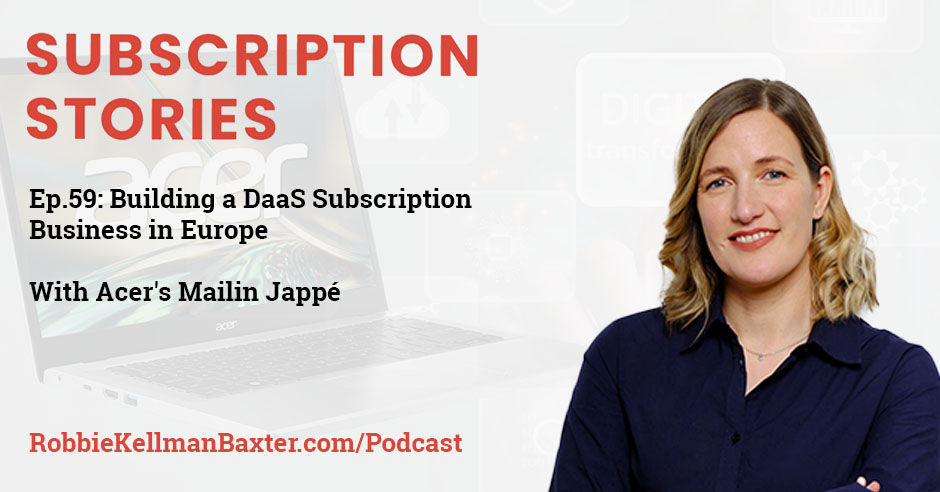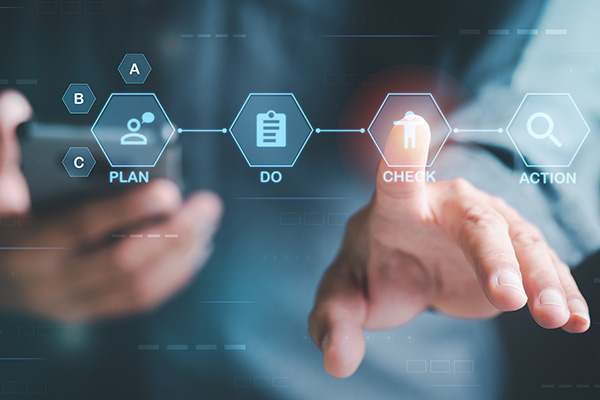
The Device-as-a-Service (DaaS) Market is expected to Surpass $190 Billion by 2026, according to Market Research Future. That’s a compound annual growth rate,of of 55.8%. Acer is at the forefront of that wave, and today’s guest, Mailin Jappé, launched and now runs Acer’s DaaS business for Europe, the Middle East and Africa (EMEA). It’s hard enough to launch a subscription startup on your own—doing it inside a large manufacturer adds a whole level of complexity.
In today’s conversation, Mailin shares the challenges she faced in launching the business, how she’s transformed the culture to one of access, not ownership, and the right kind of team to support subscription innovation in manufacturing.
—
Listen to the podcast here
Building a DaaS Subscription Business in Europe With Acer’s Mailin Jappé
The Device-as-a-Service market is expected to surpass $190 billion by 2026 according to Market Research Future. That’s a compound annual growth rate of 55.8%. Acer is at the forefront of that wave. Our guest, Mailin Jappé, launched and runs Acer‘s DaaS business for Europe, the Middle East, and Africa. It’s hard enough to launch a subscription startup on your own. Doing it inside a large manufacturer adds a whole level of complexity.
In this conversation, Mailin shares the challenges she faced in launching the business, how she’s transformed the culture to one of access, not ownership, and the right kind of team to support subscription innovation in manufacturing.
—
Mailin, welcome to the show.
Thank you for having me.
I’m excited to talk to you. I want to jump right in and understand how you came to run the Device-as-a-Service subscription business for Acer.
At that time, we saw a lot of people and partners of us talking about Device-as-a-Service. They were like, “This is the next big thing that’s coming. That’s the market expectation. It’s going to be big.” We asked ourselves, “What is that?” Everyone was talking about it, but it was not that there was a definition of what that was. Everyone said, “Device-as-a-Service.” In the US, when you were talking to Americans, they were saying, “Desktop as a service, so virtual desktop.”
Also, there were some different wordings in the US and Europe. It was like, “What is Device-as-a-Service?” “It’s something like car leasing, but then you have petrol included.” Someone else said, “No. It’s the entire IT infrastructure as a service in a leasing model.” Some others said, “No. It’s that you can have access to your entire IT on a flexible model and you can cancel your subscription every month.” It was the first point or first understanding and talking to a lot of people everyone said, “This is coming,” but not being very specific and concrete about what we were talking about.
The first couple of weeks and months I spent were on talking with different industries from industries like software that was very advanced. There is the example of Adobe which went through this change and transformation from transactional sales into full subscriptions and SaaS to traditional banks that do leasing or equipment finance for some time already. Everyone had a bit of a different take on what it would be. We had to define for ourselves what we want to achieve as a company, but even more so, what the customers are looking for and what is driving this trend.
We came to a couple of conclusions. We said in the past every machine that was delivered to a customer would need some manual touch on it. That is uploading some software and some settings so that people could start working on the machine. With Cloud adoption, a lot of those things can be done remotely. A partner who delivers the service doesn’t need to touch the device anymore. Is that okay?
Even though we’re talking about PC as a Service or Device-as-a-Service, there is a big part that is software that empowers or makes the value proposition to the end customer. We said, “We need the hardware, but we also need software so that we can deliver service to the end customers so that they can work. What else do they need? They don’t want that product or hardware to fail, so we need some more managed services around.” For us, we define Device-as-a-Service as a combination of hardware, software, and services. It could be from installation to data wiping at the end of the use. It is all that together in a subscription on a monthly or quarterly basis.
It sounds like when you were tapped to lead this, there was a lot of clarifying that you had to do before you even started to prepare for the business. There were a lot of agreements and definitions that had to be established. How did they decide that you would be the right person to lead this? As you pointed out, it’s a very new space, so what made you qualified to lead the charge?
There was a lot of luck in the game. I always said after being with the company for almost fifteen years, I covered different roles in the company. I did a lot of project management and built up different departments. What all those had in common was that it was always cross-functional. It was not specialized into one department. That helped me to connect the dots. It has an implication for finance, IT, marketing, and sales. I expressed that what I’m interested in is innovation and creating new things. That was what it was in the past. It was to create new teams and new departments. With that, it got even one step further to create a new business like a startup within the corporation.
Something that I’ve seen at some large organizations like Acer when they introduce subscription is they bring in an outsider who has some subscription experience. Your path is different. Your strengths sound like you knew the organization well. You had cross-functional expertise with this particular company. You knew players. You have credibility. If you were giving advice to some other large company that was going to go into Device-as-a-Service kind of a business, can it be done by an outsider? Do you think it’s a better choice to look for somebody that has this internal credibility and experience even if they don’t have the deep subscription expertise?
It is about someone eager to build a new business and curious enough. For sure, the internal connections help, but I can also see someone coming in from external that is qualified to build fast connections. It needs to be a networker because it drills down from the strategic level to the very operational level when you execute. It is also someone who has strong project management skills.
You need a networker to successfully launch a DaaS model. It drills down from a strategic to operational level when you actually execute. Share on XAt that time, we were at a different stage than we are now. If I look at the market now, people have a bit more understanding of what subscription is all about. You can maybe also find talent in the market even though the market is not so big yet. At that time, it was not that we could go to one consulting firm and say, “Can you please give me the expertise?” There was expertise in different areas. It was talking to banks. They have a strong expertise of many years on the leasing part, but having this vision that it needs to be digital, customer-focused, and driven by the Cloud, each of the external partners could only deliver expertise in one field. It had to be brought together.
That’s interesting. I like how you’re bringing the innovation, networking, and project management as being important core skills, especially for an organization where you’re writing your own playbook where you don’t say, “We’re going to be like Netflix except we’re going to have sports instead of comedies or whatever.” It’s a big change. Can you describe the Device-as-a-Service business for Acer? This is to give the audience a sense of how big it is, how far you’ve come in the last couple of years, and what kind of role it plays for the organization in EMEA or even globally.
We started with some test countries where we launched an online platform targeted at B2B customers. It is self-service where they could, like LEGO bricks, design their own solution. They are like, “I want to have a premium service. I want to have that hardware. I want to have that software with it.” The entire checkout would be digital, so that means signing a digital because it goes into all the regulations of a leasing contract once it’s going into the banks, etc.
We built this entire process and launched that in several countries. That’s where we see, “That is targeted at SMBs (Small and Medium-sized Businesses)” We expected B2B customers to be ready for that much digitalization. One of the learnings we had is it still needs a sales-led approach. They are looking for human interaction. They need consulting during the sales. With that is also the experience of seeing, “What kind of customers are looking for the solutions? Which companies are also maybe already more Cloud-driven?”
We pivoted past the pure Device-as-a-Service as we envisioned it in the beginning. We launched what we call the Acer Smart Financing Model with our partners together, where we put installation services in, but it is delivered by our partners to the end customers. It is amplifying the platform. It is a bit less digital than we envisioned it in the beginning but more consultative. It is also looking at bigger tickets than the self-service online platform.
At this point, is that where most of your relationships are financially driven? I’m a subscription person. There are a lot of benefits to SaaS or Software as a Service model beyond the way that it’s paid and recognized. Do you feel like that’s been the tip of the spear in terms of what gets large organizations to start this? It’s a big transformation to move to this kind of model.
We’re seeing different drivers. We are seeing the macroeconomic environment and the importance of cash. There is a financial part of it, and that is resonating very well. We, as a company, clearly commit to the ESG goals by being net zero by 2050 and bringing in circular economy models where we take back the goods at the end of the lifetime where, nowadays, the majority of PC hardware ends up in landfills. It is taking that ownership as a vendor and saying, “We take care of the end of life, whether that is a second life or proper recycling.” Therefore, we are also giving our customers the confidence that, with those solutions, they are doing the right things in terms of sustainability and ESG.

Device-as-a-Service: By taking ownership as a vendor and taking care of the end-of-life cycle of devices, customers can gain confidence that they are doing the right thing in terms of sustainability and ESG with those solutions.
Those are the two things, the traditional leasing benefits or CapEx to OpEx, the sustainability part, but then also the ease of use. Why should IT resources be so limited in the market? Why should I have a part of my team look after my internal IT assets if I could have that covered by service and move them onto projects that are maybe more interesting for them and where they can drive value for the company?
It’s so interesting. I remember a lot of these same issues coming up with SaaS or with Software as a Service where we, as marketers, had to get clear on which benefit is going to drive acquisition because of the acquisition required to change in thinking. In some organizations, it was about cash management. Sometimes, it was about focus, convenience, or something else. How important is it to know which of the benefits, especially in the early stages when you’re doing something new, are the ones that are resonating?
I’m especially interested in what you said about ESG, sustainability, and circular economy. When I started working in subscription, it never occurred to me that that would be a benefit. Especially in the world of physical products, it becomes a big value to say, “I can give you all of the old hardware. First of all, it’s not my problem, but maybe you’re going to do something better because you’re more sophisticated and have more volume than we do.” That is a driving benefit, especially for organizations that have a public ESG commitment.
We have the ESG commitment that we have, but also as the only vendor, we have our own service operations. That puts it all together so we can be in control of this entire chain up to recycling. It was not the first thought that we had when we started. Coming back to your point, it is understanding what the customer’s needs are.
In the past, we had to position our product from a specs perspective. What kind of CPU do you have? What kind of storage is in there? What is the look and feel? Now it’s getting much broader. In the beginning, it was like talking to the head of IT, and he could select the product. This time, maybe one argument goes with the CFO, and one argument goes with the CSR office. Some of the arguments rather go with the CEO. Also, the selling is becoming much more complex 360 degrees.
That’s interesting, which probably helps though. It’s more complex, but also, IT can be hard to sell to. If the CSR team has some leverage, they might tip the scale in your favor. It’s more complicated, but it gives you more levers. I wanted to ask you. You’re running EMEA. I’m very US-centric. I’m provincial. I try, but I end up having a lot of American companies and American executives. I’m happy to have the opportunity to hear about your experience. I’m interested. Are there things that are different about operating in your region when you talk to your North American counterparts, Asian counterparts, or Latin American counterparts that are different that you have to think about or that somebody should think about if they’re coming into Europe with a subscription?
From a European perspective, one of the most obvious ones is languages. Even though we have the Euro, it’s still currencies as well. We have big markets that are maybe more similar to the US, like the UK, but Brexit brought a lot of challenges with it. Especially when it’s bad shipping, how do we do a service? We have maybe European directions on regulations. Each and every country, especially when it goes into a part of the solution being financed, goes into local regulations. That needs very specialized lawyers that understand local regulations, how to interpret them, and how to build solutions around them. It’s not that you can build a subscription in one country and scale.

Device-as-a-Service: When launching in different countries, work with specialized lawyers. They will help you better understand local regulations and determine how to build solutions around them.
That’s interesting. That’s a lot of regulation in the whole financial element. For many of your clients, it’s a financing play as something important, and you have the hard assets. One of my early guests was the person who runs Hewlett-Packard, their Instant Ink business, Anthony Napolitano. He was talking about these kinds of issues and the additional level of complexity of hardware leasing or thinking about that as part of the overall package. He was here in North America, but with the European additional regulations, additional languages, and additional currencies, it is complicated.
It’s about defining which markets to go first and which cultures to navigate first. Also, on top of the complexity that comes from regulations, there is also different culture of readiness. Maybe some markets are still more looking for ownership rather than usership, where the possession of goods is, “Why should I pay for something that doesn’t belong to me?” You need to have different discussions than in another market that says, “I want to have as little as possible. I’m not interested in the ownership of the asset.” When we’re looking at markets there, it can be even in consumer markets.
DaaS launches depend on different cultural readiness. Some markets are still looking for ownership, while others are open to getting usership. Share on XLooking into the Netherlands, there is a company called Swapfiets in the consumer space where a lot of people are using bicycles as subscriptions. If you do that as a person on a daily basis, also the assumptions or hypotheses those people take into the business world are very different ones than some countries that still tend to own everything.
Is it the Nordics that are the most subscription-ready or UK? Which areas do you think are more ready both on the consumer side, which you have perspective there, and certainly on the B2B side?
The UK is ready, and the Nordics from a cultural perspective as well. The Nordics as a market are markets that are fairly small, so adding a lot of complexity for the size of the market. In general, the North is maybe more ready than the South.
I have a concept. I talk about a forever promise. It’s the idea of what it is that your best customers would say to their colleagues, friends, and peers about why they’re loyal to you. They’re like, “We subscribe to Acer DaaS because we’re confident that they will always,” something around continuous something. How would you describe that promise that you’re making to them?
It’s a promise that we allow them to focus on their work without having to worry about their IT infrastructure. It’s almost like, “Why should I worry about the modem if I’m just interested that I have access to a good internet connection?”
As you’re growing, what has been most challenging as the leader of this subscription business inside a large successful manufacturing-led and services-led organization?
A lot on the technical side, setup side, and financial side is project management and execution. The biggest challenge I find is culture and mindset shift. Coming from a history where it’s about transactional sales where it’s a lot about product where historically engineers led the company, and that is the pride where they come from. It’s the product, it’s not the business model.
This is where we had defined innovation. Innovation was around the product. You build the greatest product, but then someone comes and says, “The product is a must-have, but there’s much more around it. You need to know what the customer does with your product.” And then Coming back from there and then saying to the local organizations and to sales, “How does your end customer use the product? What does he do with it? What are his biggest concerns? What are his needs? What kind of problems can you solve?”

Device-as-a-Service: Innovation must be done around the product. You need to know what the target customer does with it.
When we see the market, there’s hardware and all the services that are around it. This market is much bigger, because that drives the value of the product. We need to get closer to understanding what our customers want, and if that is that I need to have a coffee every morning at 10:00 AM next to my laptop in order to function.
That is really hard. I’ve been working with subscription businesses for a very long time. It’s only in the last couple of years that I became aware of the cultural challenges of moving to subscription. It’s not just the financial logic that says, “We’re going to make more money. We’re going to have more influence. Recurring revenue gets a higher multiple,” and those kinds of things. It is people saying, “I came to this company because I build hardware. I’m an engineer.” Suddenly, it’s not the most important thing, and it is like, “I’m wondering if I should go somewhere else.” That’s an issue. There’s the logistics of “How do we become customer-centric? We don’t have a place to track this kind of data. We don’t have a team that’s responsible for it.”
There’s this question I was talking about with a very large manufacturer. Tell me if this resonates with you. This person is responsible for their nascent subscription business. He said, “We don’t even have the right business development function to make a deal. If a digital player comes in that’s going to help us accelerate our subscription business, we don’t have anybody to receive the money if they want to pay us for that. There’s no infrastructure for this way of doing it.” Finally, subscription revenue comes in a very different way. That’s why your customers love it. You pay a little bit at a time. The numbers are small at the beginning because ARR takes a little while to become impressive. There’s that concept of swallowing the fish. I don’t know if you’ve seen this, but it’s 4 to 6 years.
It’s swallowing the whale for all kinds of hardware businesses because it’s even more so.
I love that. Swallowing the whale is a new term. It is hard for the company. There are project management challenges, but there’s also change management, which is the emotional piece or the trust piece. It is like, “Is this still a good place for me if suddenly we’re valuing customer centricity more?” The hardware is one piece of the solution in all of that. I’m glad you brought that up.
I’m having conversations where it’s about, “It’s my margin today. This is where my KPIs are. I need to deliver this quarter’s revenue or this quarter’s margin. This is what I’m paid for, and then you’re telling me that I should be interested in long customer relationships that will pay off in 3, 4, or 5 years from now. How do you incentivize me for that? What is my benefit today if I do that?”
These are your peers.
Those are my sales.
How do you handle that? Do you go up to the top and look for some kind of executive sponsor? Do you go more peer-wise over to the sales team and say, “We need to change compensation plans?” What advice do you have? How do you do that?
There is no either/or. It needs top management endorsement and full backup. Bringing something new like that to the market and changing your organization, you feel like you are someone from the moon, and they look at you and say, “You haven’t understood our business from what you’re telling us.” You need this backup from top management to say, “This is the way forward,” and also to experiment and to try things on how to make it work.

Device-as-a-Service: Launching a subscription business within an established organization needs top management endorsement and full backing. Sometimes, it feels like bringing something new to the market.
It’s also as important as talking to the field forces and explaining again. It’s the field of expertise. I’m in my world every day, but for them, it is just a part of their business. Maybe they see a presentation and they forget about it until someone knocks on their door and says, “We need to push that business,” until they’ve understood.
We went in a couple of directions. We put in incentive plans and changed compensation schemes. We also changed hiring processes or hiring profiles. We looked for very different profiles when filling open roles with expertise, maybe not in the PC field but in the as-a-service field. That could be all kinds of services. That could be software. It could even be a car, but someone who’s familiar with the concept of recurring revenue and how to sell it.
They are different kinds of people. Something that we haven’t talked about but I’m guessing is an issue is when you sell hardware traditionally. If I buy a laptop, it’s mine. If I use it like a typewriter and all I do is use my word processing application, and that’s it, that’s my problem because I’ve already paid for it. Even if I paid for a super powerful machine, if I’m subscribing to it and I’m not using any of the great features that you’ve invested in, I might say, “It’s not worth it to me,” and I might cancel.
Suddenly, you have more responsibility for the after-sales relationship because they can leave. If you sell something outright and they don’t like it, maybe the next time they buy, they won’t buy from you, but you have time. What do you think about that post-sales piece of the pie? Have you changed how that’s done at Acer or specifically for your team?
What we looked at were the capabilities that our service centers have to put different service packages together that allow for constant customer interactions. Already, monthly billing is one kind of interaction. Maybe the first thing that someone who isn’t happy would do is he stops paying. If a product breaks down, if you bought it, you maybe put it in the drawer and buy a new one. You would maybe stop paying a subscription if your product breaks.
We have a chance at that moment to solve that and say, “What do you need? What do you use it for?” They’d be like, “I gave a high-end device with the best service that was supposed to be for one of my data crunchers. I gave it to the receptionist.” At the receptionist, maybe it needs a very standard device. Having this conversation and then being able to adapt is the power of subscription.
You can see how they’re using it. You can see, “This person has a very powerful computer, but they’re not using it that a person with a powerful computer should be.” I’m guessing you do this. You’re like, “Maybe we can raise that flag with our customers before they cancel.” We’d say, “It looks like you’ve got a specialized machine with somebody who’s underutilizing it. Do you want to swap that out? Either we’ll give you a lower-grade machine, or we’ll give it to a different person.” People have to be trained to do that because, at least in my experience, service centers are used to solving problems when the problem is brought to their attention as opposed to saying, “Judging by how they’re using this, they haven’t complained yet,” but that’s a problem waiting to happen.
My vision is becoming service centers, but at the same time, almost presales. If you can do that proactively, the limitations on that is maybe another uniqueness to Europe that we’re, at the moment, not yet allowed to use that data. Technically, it would be feasible, but we cannot access that usage data. As IoT evolves, we get more data about usage as well, maybe in ways that are anonymized and made available only to the customers so that the customer can make those decisions. Unfortunately, we are not there yet, but that’s my dream that we could see how you use the subscription and then, based on that, make recommendations for the renewal.
It could even be before the renewal to say, “We see that 17% of your highest-grade computers are being underutilized.” It’s the same issue with phone companies that are like, “You’re not using your data plan.” I love that when they call and say, “Can we downgrade you because you’re not using it?” rather than waiting for me to realize, “I am completely overpaying.”
I do see Europe’s always protected privacy much better than we do here, but there is a benefit to sharing your information. You can often get a better experience, so there is a tradeoff. We talked a little bit about what you’re hiring for you. You talked about the different cultures that you need for sales. Are there places where you need to hire differently?
Sales is the biggest part. Depending on the readiness and background of people and also certain management roles, if you need certain organizations to change more, it needs to have one missionnaire in each organization that advocates the solution and says, “We need to do this,” and understand the long-term vision to make the impossible possible. Sometimes, it feels like pulling a leg and arm at the same time for very little revenue in the short term.
If you need certain organizations to change more, they need to have one missionnaire. They advocate the solution to move the plan forward and understand the long-term vision to make the impossible possible. Share on XIt is much easier to maybe sell two containers full of PCs. If that’s a tradeoff of your resource time, if you don’t understand why it is so important to do this new business, you would always fall back to the old way of doing things. The old way of doing things feeds the company, so it is important. We cannot neglect that. Core business is important while developing at the same time the future.
That’s almost the hardest time. It is when you’re running two separate businesses with different approaches. Do you have time for a quick speed round?
Yes.
What is the first subscription you ever had?
Mobile phone.
What is your favorite subscription, business or personal?
Spotify.
Desktop, laptop, or phone? Which do you use most?
Phone.
What is your favorite European-first subscription? Spotify is probably a good example, but maybe one that we might not know about in the rest of the world.
What I loved were diaper subscriptions when the kids were small.
That’s awesome. I love that. What is your best piece of advice about building a subscription business inside a hardware company?
Don’t start with business plans. Start with testing and learning.
I love it. Thank you so much for being a guest on the show. It’s been a pleasure and a great learning experience for me to talk to you.
—
That was Mailin Jappé, Director of Everything as a Service for Acer. For more about Mailin and Acer, go to Acer.com. For more about the show, go to RobbieKellmanBaxter.com/podcast. Also, if you like what you read, please go over to Apple Podcasts or Apple iTunes and leave a review. Mention Acer, Mailin, everything as a service, and this episode if you especially enjoyed it. Reviews are how people find our show, and we appreciate each one. Thanks for your support and thanks for reading.
Important Links
- Mailin Jappé, Director XaaS, Acer
- Acer
- Cloud adoption
- Swapfiets
- Acer.com
- Subscription Stories Episode 6: Instant Ink’s Anthony Napolitano on Reinventing the Razor and Razorblades Model by Focusing on Subscriber Outcomes
About Mailin Jappé
 Mailin Jappé is Director XaaS at Acer, responsible for the strategic management of launching disruptive and digital business models in the EMEA region to support sustainable company growth and transformation.
Mailin Jappé is Director XaaS at Acer, responsible for the strategic management of launching disruptive and digital business models in the EMEA region to support sustainable company growth and transformation.
As an intrapreneur, Mailin is fascinated by tech, innovation, strategic thinking and solutions that can help to address the big challenges of today and tomorrow.
With strong expertise in digital, cross functional leadership, and an open minded attitude, Mailin has introduced Acer Device-as-a-Service – Acer’s subscription business model and circular asset approach.
Mailin holds an MBA with specialisation in Entrepreneurship from IE Business School, Spain, and graduated with a B.Sc. Business Administration & Information System from the European Business School Oestrich-Winkel, Germany, and the University of Hong Kong.
Love the show? Subscribe, rate, review, and share!
Join the Subscription Stories Community today:
